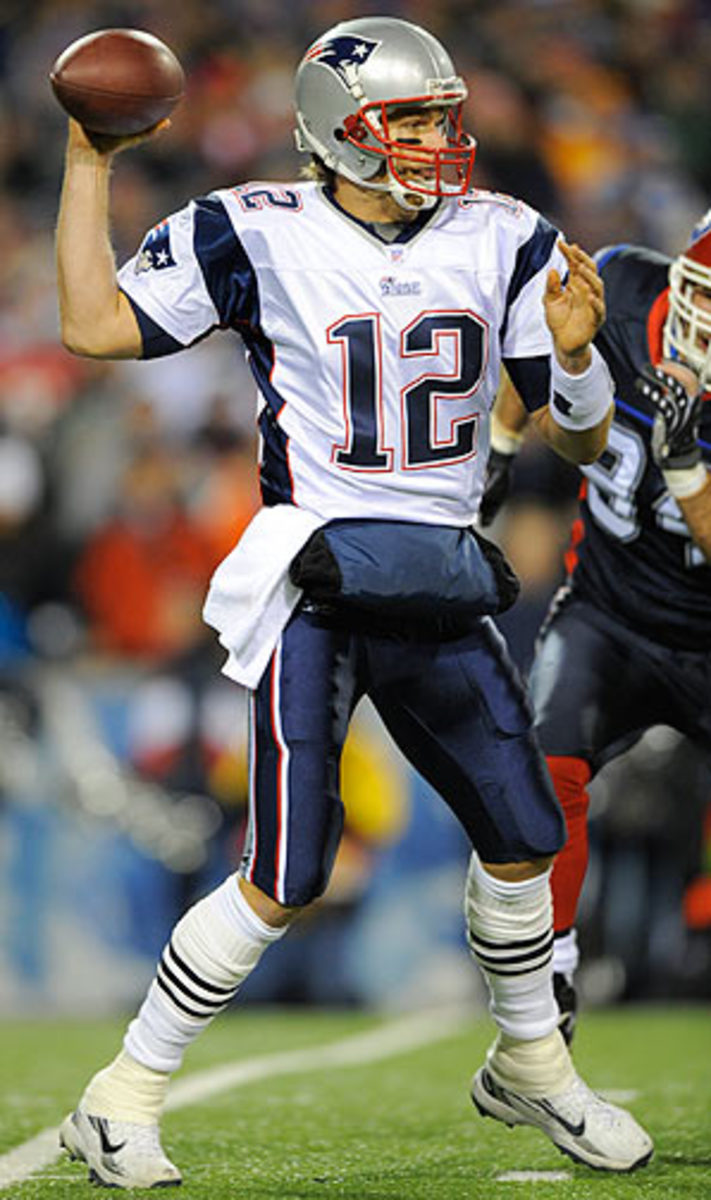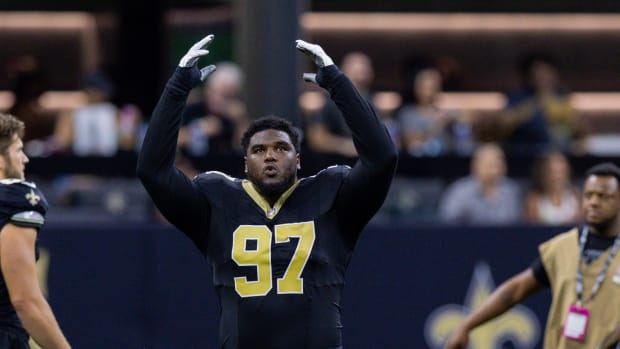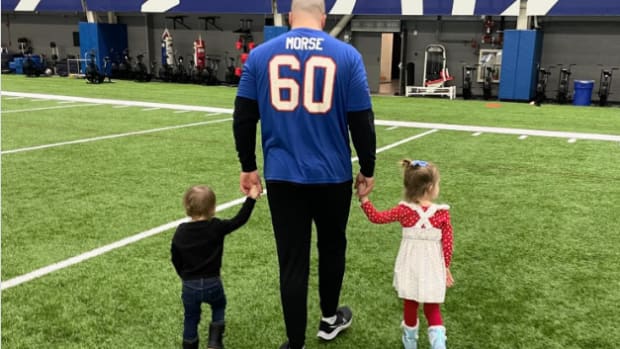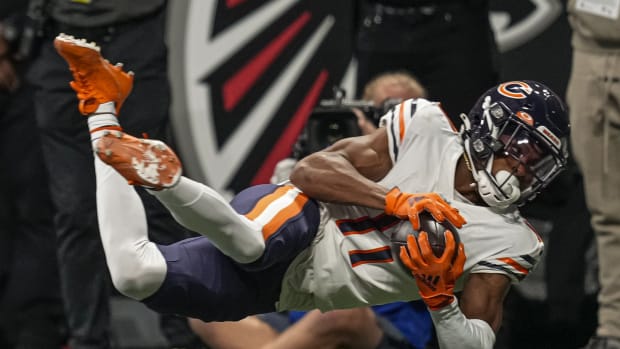
Best individual seasons of 2000s
The first decade of the 21st century is rapidly coming to a close, and it's been one of the most explosive periods in pro football history -- especially on offense, where it seems new records were set each and every year.
So what have been the marquee performances of the decade so far? Here's our take, with one signature season at each position. (Send comments to siwriters@simail.com)
Tom Brady, New England, 2007398 of 578 (68.9%), 4,806 yards, 8.3 YPA, 50 TD, 8 INT, 117.2 passer rating
The Patriots quarterback was a three-time champion heading into the 2007 season, but he had a reputation as a dink-and-dunk passer throwing to a series of Smurf-life journeymen at wide receiver.
Given a premier weapon as a batterymate -- record-setting wideout Randy Moss -- Brady exploded with the greatest season by a quarterback in this or any other decade. His 50 TD passes are a record. His TD-to-INT ratio is a record. His passer rating is the second highest in history. His 4,806 passing yards stand as the fourth most in history. Even his 68.9 completion percentage is among the best marks in history.
Oh, a couple other things: One, Brady guided the Patriots to the most points in NFL history (589), though the 1950 Rams actually averaged more points per game (38.8 to New England's 36.8), though it came largely against a schedule loaded with expansion teams. And two, he was the single most important force behind the only 16-0 season in the NFL record books.
There was only one little problem: Brady and the Patriots failed to put away the Giants in Super Bowl XLII.
Honorable mention: Peyton Manning, Indianapolis, 2004
LaDainian Tomlinson, San Diego, 2006348 attempts, 1,815 yards, 5.2 YPA, 28 TD; 56 catches, 508 yards, 3 TD
In a crowded field of contenders for best performance by a running back this decade, Tomlinson stands above the pack with one reminiscent of Clark Kent's days at Smallville High.
His 1,815 yards and Jim Brown-esque 5.2 YPA on the ground are worthy enough on their own of consideration. But add in a record 28 touchdown runs, along with 56 catches and another 508 yards through the air and you have a performance that will stand the test of time. His 2,370 yards from scrimmage is third best in NFL history, behind Marshall Faulk in 1999 (2,429) and Tiki Barber in 2005 (2,390). Barber might have earned the lead in the performance-of-the-decade race, but his 11 TDs were easily overshadowed by L.T.'s jaw-dropping record of 31 here in 2006.
Tomlinson wasn't done, either: he lost just two fumbles all year on 404 touches and led the Chargers to 492 points, tops in the NFL that year, as San Diego enjoyed a franchise-best 14-2 record.
Honorable mention: Marshall Faulk, St. Louis, 2000
Terrell Owens, Philadelphia, 200477 catches, 1,200 yards, 15.6 YPC, 14 TDs
The first years of the 21st century have been the decade of the wide receiver. Indy's Marvin Harrison smashed Herman Moore's single-season record for receptions (123) with a dizzying 143 catches in 2002. New England's Randy Moss rewrote the record for touchdown catches in 2007 with 23, surpassing the legendary Jerry Rice (22) in the process.
But no receiver has made more headlines on and off the field this decade than Terrell Owens. He's hauled in a single-decade-record 109 TD receptions since 2000, while shooting his way out of three towns.
And in 2004, the year that Owens arrived in Philly for a whirlwind romance with Donovan McNabb and Eagles fans, it seemed the NFL was all T.O., all the time. He delivered something for everybody -- from success-starved Philly fans, to sports writers hungry for juicy storylines.
On the field, Owens set a franchise record by hauling in 14 TD receptions while leading the Eagles to a franchise-best 13-1 record through 14 games. A fractured fibula and sprained ankle in Week 15, though, appeared to put an end to Philly's title hopes. But thanks to Owens' now-famous hyperbaric chamber, he returned in time to haul in nine catches for 122 yards in a hard-fought 24-21 Super-Bowl loss to the Patriots.
The Owens-Philly romance ended in a nasty divorce the following season, as you knew it would. But for 2004, anyway, the football world seemed to rotate around a single volatile star at wide receiver.
Honorable mention: Randy Moss, New England, 2007
Tony Gonzalez, Kansas City, 2004102 catches, 1,258 yards, 12.3 YPC, 7 TD
In the turbulent wake of the Herm Edwards offensive debacle in Kansas City, it's easy to forget that the Chiefs were one of the league's dominant offensive forces in the middle of the decade.
And during this period, a tight end was the most dangerous weapon on one of the league's most explosive teams.
Gonzalez's 2004 season stands as perhaps the greatest pass-catching performance by any tight end ever. His 102 receptions were a career-high -- the league's best that season, and the most by any tight end in history. Gonzalez, in fact, is the only tight end to lead the NFL in receptions in nearly a quarter century (Raiders great Todd Christensen was the last, with 95 catches in 1986).
Gonzalez caught seven TDs that year -- a fairly good harvest for a tight end, but hardly dramatic. However, the attention he drew from linebackers certainly opened plenty of room underneath for Kansas City's stable of running backs who, led by Priest Holmes, scored 31 touchdowns that year as the Chiefs racked up 483 points -- one point shy of the franchise record set the year before.
Honorable mention: Antonio Gates, San Diego, 2005
Orlando Pace, St. Louis, 2001
At the height of his powers, Pace didn't block pass rushers; he absorbed them almost effortlessly into his massive frame, like a ShamWow soaking up a pesky cola spill.
And the 2001 season marked the height of those powers this decade. Pace was an easy selection for every all-star team in existence that year, while serving as the anchor at left tackle of the first and only team in history to top the 500-point mark for three straight seasons.
Pace was there for every single offensive snap of the season, while starting every game for the fourth consecutive campaign. The Rams won a franchise-record 14 games, and the offense could do no wrong.
Quarterback Kurt Warner, on his way to his second NFL MVP trophy, was sacked just 38 times in 584 drop backs behind the wall Pace provided, while leading the league in virtually every major category, including 4,830 passing yards -- a mark that still stands as the third most all time. Superstar running back Marshall Faulk was at the top of his game, with 2,147 yards from scrimmage, while Isaac Bruce and Torry Holt made for a nearly unstoppable tandem at wideout, combining for nearly 2,500 yards in receptions.
It was a dream season for the league's best tackle. That is until Warner was nearly knocked senseless in a devastating Super Bowl loss to the Patriots that marked the death of one prospective dynasty and the birth of another.
Honorable mention: Walter Jones, Seattle, 2005
Alan Faneca, Pittsburgh, 2005
In the signature play of the '05 regular season, the one that launched the Steelers on their Super Bowl charge, Faneca was in the middle of the fireworks. It was Week 14 when the Steelers, losers of three straight, hosted the Bears on a snowy day at Heinz Field. Pittsburgh was at the Chicago five-yard line, staring into the teeth of the mighty Bears defense and clinging to a 14-9 lead. Faneca, the left guard, pulled to the right and led workhorse Jerome Bettis through a gash that had formed in the Bears defense. Faneca took down defensive back Michael Green, but Bettis did the rest. Racing past Faneca's block, he pancaked middle linebackerBrian Urlacher like a short-order cook with a bad temper. Bettis then kneed Urlacher in the facemask, snapping the linebacker's head back as he crashed into the end zone.
The brutal five-yard touchdown sparked the struggling Steelers, who would not lose again that season.
But Faneca wasn't done. In Super Bowl XL, he again pulled to the right, this time obliterated linebacker Leroy Hill, who attempted to fill a hole in the defense. The block launched running back Willie Parker on a Super Bowl-record 75-yard touchdown run.
The 2005 Steelers were one of the few teams since the 1970s who won a Super Bowl by running the ball more often than they passed it. And Faneca, who enjoyed a season of Pro Bowl and All-Pro honors, as he did the entire decade, was one of the leading forces in the effort.
Honorable mention: Will Shields, Kansas City, 2003
Jeff Saturday, Indianapolis, 2006
The Colts scored 427 points in 2006 -- good enough for second in the league -- and Saturday, then in the midst of a three-year Pro Bowl run, and his mates were a big reason for the success. They protected QB Peyton Manning to a tee, allowing just 14 sacks in 571 dropbacks (2.5 percent) all season -- one of the best rates of pass-protection success in NFL history. Saturday's squad also opened enough holes to allow rookie running back Joseph Addai to rip off 1,081 yards on just 226 carries (an impressive 4.8 YPA).
But the best was yet to come: Saturday and the Colts produced the greatest comeback in conference title game history that year, against their nemeses from New England no less. It was a comeback some Colts credited to Saturday's impassioned speech the night before the game, telling his teammates that "it's our time." Dungy restated Saturday's cry at halftime.
The Colts, who trailed 21-6 at the break, emerged with a 38-34 victory. Saturday played a large role for a center, too: he pounced on a fumble in the end zone for a touchdown that forged a 28-28 tie in the fourth quarter. Later, he steamrolled New England's mammoth nose tackle Vince Wilfork, which allowed Addai to race three yards up the middle untouched for the game-winning score with one minute to play.
Saturday and the Indy offense shredded the once-proud Patriots defense for 32 first downs that day -- the most ever in a regulation playoff game -- and the Colts went on to bigger things two weeks later: beating the Bears in Super Bowl XLI to end years of postseason futility for the organization.
Honorable mention: Matt Birk, Minnesota, 2007
Ray Lewis, Baltimore, 2000107 tackles, 30 assists, 3 sacks, 3 fumble recoveries, 2 INT
Lewis kicked off the decade with a head-smashing bang that still echoes around the league.
In fact, he did it all in 2000: He was named Defensive Player of the Year, Super Bowl MVP and he led the single toughest defense of the Live Ball Era (1978-present), a unit that surrendered just 10.3 PPG. The 2000 Ravens were virtually impossible to run on, too; they allowed opposing ball carriers just 2.69 YPA, the lowest mark any defense has allowed in the Super Bowl Era.
Lewis' 2000 Ravens were to modern defensive football what Tom Brady's 2007 Patriots were to modern offensive football -- except that Lewis actually walked away with all the postseason hardware.
Nearly a decade later, he remains one of the league's preeminent forces on the field and one of its preeminent personalities off the field. But he, and 21st-century defensive football, was never as good as it was in 2000.
Honorable mention: Barrett Ruud, Tampa Bay, 2007; Brian Urlacher, 2001
Ronde Barber, Tampa Bay, 2002 79 tackles, 3 sacks, 2 INTs
Barber had a better individual season in 2001, when he hauled in 10 INTs to tie the record for most by any defender since 1982. But in 2002, he was the leading force on the best pass defense of the past two decades -- a unit that would carry the Buccaneers to the first and only Super Bowl championship in franchise history.
That year, the Bucs led the league in total defense and scoring defense, allowing just 196 points. For a little perspective, that's two fewer than the number of points allowed by the legendary 1985 Bears.
Barber's Bucs posted a tremendous 48.4 defensive passer rating that season, the lowest mark any defense has allowed in the past 20 years and the lowest mark any Super Bowl champion has surrendered since NFL rule changes opened up the passing game in 1978, spawning the Live Ball Era of pro football.
The stifling nature of the Tampa pass defense was on full display for the nation in Super Bowl XXXVII, when Barber and the Bucs embarrassed Oakland quarterback and 2002 NFL MVP Rich Gannon. Tampa picked him off five times, returning three for touchdowns in a dominating 48-21 victory.
Barber is a sure-fire Hall of Famer, the active leader in defensive touchdowns (11) and the only cornerback in history with 20 or more sacks and 20 or more INTs on his resume. The 2002 season was his finest hour.
Honorable mention: Antonio Cromartie, San Diego, 2007; Asante Samuel, New England, 2006
Ed Reed, Baltimore, 2004 76 tackles, 2 sacks, 9 INT, 358 return yards, 2 TD
Reed is one of the most dynamic forces in pro football -- one of the rare defenders in the history of the league with a quantifiable ability to put points on the board and change the outcome of games.
And 2004 was his signature season, one in which he earned NFL Defensive Player of the Year honors thanks, in large part, to a series of explosive plays rarely seen from any defender.
Reed led the league with nine interceptions, while setting a single-season record with 358 interception return yards. He even set a record for the longest INT return for a touchdown in history in 2004, picking off a Cleveland pass in his end zone and then returning for what went into the books as a 106-yard score (he surpassed that mark last year with a 107-yard return for a score). Reed added one other score in 2004, scooping up a fumble and returning it 22 yards for a touchdown that proved to be the difference in a 17-10 win over the Redskins.
The season did not necessarily go well for the Ravens. The team went just 9-7 in 2004, despite surrendering just 268 points. But for one year, Reed made a bigger impact at safety than any other player this decade.
Honorable mention: Troy Polamalu, 2008; Bob Sanders, 2007; Rodney Harrison, 2004
James Harrison, Pittsburgh, 2008 101 tackles, 16 sacks, 1 INT, 1 safety, 7 forced fumbles
Simply put, Harrison in 2008 was the best player on one of the best NFL defenses in years. It was a defense that could go, statistically, toe-to-toe with the legendary Steel Curtain of the 1970s, and it was a defense that carried the Steelers to their record sixth Super Bowl title.
Harrison's production says it all: 101 tackles, coupled with 16 sacks, making him a deserving recipient of NFL Defensive Player of the Year honors.
He led a defense that surrendered just 4.71 yards per pass attempt last year, one of the stingiest marks in modern NFL history and easily the best of 2008. The Steelers were also the toughest team to run on in '08. They allowed 3.29 yards per attempt on the ground. To put that mark into historic perspective that every Pittsburgher can understand: in the Steel Curtain Era, only the dominating 1976 squad surrendered fewer yards per attempt on the ground (3.22) than the 2008 team.
Honorable mention: Derrick Brooks, Tampa Bay, 2002; Mike Vrabel, New England, 2004
Albert Haynesworth, Tennessee, 200851 tackles, 8.5 sacks, 3 forced fumbles
Haynesworth could be considered a late bloomer. His first five years were solid, if unspectacular, marked primarily by a 2006 incident in which he stomped on the head of Andre Gurode, lacerating the Dallas center's face.
He exploded on the scene in 2007, and stepped it up again in 2008. Haynesworth recorded 8.5 sacks last year, a substantial number for an interior lineman, and was a leading force on one of the league's leading defenses. The Titans surrendered 234 points, second in the league last year, while the team matched a franchise record with 13 victories.
It doesn't appear the Haynesworth ascendancy will end any time soon, either. He was signed by the Redskins in February to a $100 million contract, one of the richest deals ever for a defensive player.
Honorable mention: Kevin Williams, Minnesota, 2006
Michael Strahan, New York Giants, 200122.5 sacks, 73 tackles, 1 fumble recovery, 1 TD
Strahan was a great player in the 1990s, but he became a dominant NFL personality on and off the field in the 21st century.
The '01 season was easily the best in what will likely go down as a Hall of Fame career. It was also the best by any defensive end this decade. Most notably, Strahan set a single-season NFL record with 22.5 sacks -- though not without some controversy, as then-Packers quarterback Brett Favre appeared to take a dive in the 2001 season finale to hand Strahan the record-setting takedown.
Still, even without the controversy, 21.5 sacks would been the most by any player in history save for another New York sack specialist, former Jets defensive end Mark Gastineau, who chalked up 22.0 takedowns in 1984.
The Giants struggled in 2001, finishing the season 7-9 thanks, in large part, to a moribund offensive attack that marked the beginning of the end of the JimFassel Era. But Strahan's performance was one for the ages, and good enough for him to earn Defensive Player of the Year honors -- with an assist from Favre.
Honorable mention: Jason Taylor, Miami, 2006





































